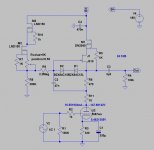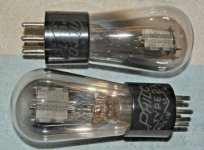The LF bandwidth is unnecessarily low, not worth going under 10Hz with "linear" section.
The R6 also "horn in" the low frequency behaviour.
Try to use lower R6, much lower C2, possibly with other operating point.
5687 is happy at higher current.
The R6 also "horn in" the low frequency behaviour.
Try to use lower R6, much lower C2, possibly with other operating point.
5687 is happy at higher current.
Attachments
Could you simulate with 0.5VAC of input, thanks?
Input_pp 1
Out_THD% 0.14
Out_pp 17.30
I guess the noDac after the LPF have max. a Vout of ~0.5V, can be 10-12dBs enough or it's too much?
12dB is only 4x.
If you want "standard" 2.82V RMS output, must to use at least 15dB gain device.
My old 12B4a preamp has about 16dB, #26 or 801a 18dB.
If you want "standard" 2.82V RMS output, must to use at least 15dB gain device.
My old 12B4a preamp has about 16dB, #26 or 801a 18dB.
Last edited:
Thanks for suggestions, I have more 26 but ST.
I set the SSHV2 to 170Vout and with the new Vin-Vout difference now is sounding good, problably increasing the difference will sound better, I will try because I have a 250VAC power tx laying a round.
I set the SSHV2 to 170Vout and with the new Vin-Vout difference now is sounding good, problably increasing the difference will sound better, I will try because I have a 250VAC power tx laying a round.
Hi Felipe
the gyrator doesn't change with "warm-up" time. It's pretty stable from a tempco point of view. I have not noticed any changes over time am afraid.
Perhaps is something else in your system. I'd also suggest trying without the cathode bypass capacitor, it will sound better in my view....
Cheers
Ale
Ale the Russian teflon caps were new when the lack of bass, now both hybrid mu-followers are sounding with high SQ. The cathode bypass capacitor adds bass so more clear without cap (I tried) thanks.
Sorry Ale, I had to say teflon capacitor "break in" not warm-up.
No worries Felipe. I think you may want to be a bit more careful and perform more research and tests before drawing to a conclusion that the 2 components “sound bad”. It gives the wrong impression which frankly isn’t useful when the issues could be anywhere in your system.
If you want lower gain, the 71a is a great valve to look for.
Cheers
Ale
If you want lower gain, the 71a is a great valve to look for.
Cheers
Ale
I know very well the 2 components, I was really surprised that using the 2 components togheter sounded bad because the 2 components are top notch SQ, so I was asking help to know what's happening. Thanks for 71a suggestion.
You have a fundamental fallacy.
Two individually good module (NOT component!) cooperation depends on good planning and implementation.
It's not "plug and play", it's requiring proper planning.
Each module output has an impact to other input, thus can change its operation, and vice versa, the parameters changing reacts module components.
If you look a gyrator as "module" and tube as "module", not cooperating component conglomerations, the final operation may be uncertain.
Two individually good module (NOT component!) cooperation depends on good planning and implementation.
It's not "plug and play", it's requiring proper planning.
Each module output has an impact to other input, thus can change its operation, and vice versa, the parameters changing reacts module components.
If you look a gyrator as "module" and tube as "module", not cooperating component conglomerations, the final operation may be uncertain.
Ale followed your advice: no bypass cathode capacitor and no SSHV2. I'm making a new one SSHV2 because I suspect is damaged.
- Home
- Amplifiers
- Tubes / Valves
- Salas SSHV2 + Moglia hybrid mu-follower

